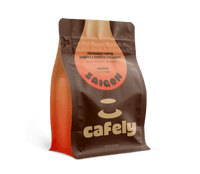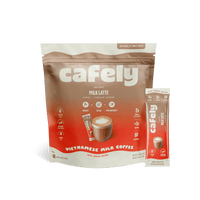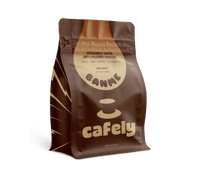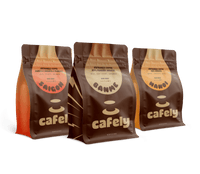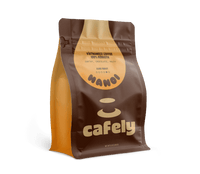Over 400 billion cups of coffee are consumed each year. It’s the world’s 3rd most popular drink (behind water and tea).
The go-to species for brewing coffee for hundreds of years has been the Coffea arabica plant — favored for its sweet, deep, bold, and nutty flavors without the bitterness associated with other types of coffee.
In this article, we dive deep into the anatomy of this plant, the history of arabica coffee and how it took over the world, how it compares to other species like robusta coffee or liberica, and the best ways to prepare and consume it…
What is Coffea arabica?

Coffea arabica is a species of “coffee plant” that’s used in around 60% of the world’s coffee production — it’s the most widely grown and consumed species of coffee in the world.
Arabica's popularity stems from its unique flavor profile, which can be described as smooth, mild, and fruity but can vary widely depending on both the cultivar and the climate in which it was grown. Arabica's flavor profile is much more complex and less bitter than other species of coffee — such as Coffea canephora (also known as Coffea robusta) or Coffea liberica. The tradeoff is that arabica coffee only contains about half as much caffeine as these other varieties.
Arabica plants are native to the highlands of Ethiopia but are now predominantly cultivated in Central and South America. Colombia and Brazil are the largest producers of Arabica coffee in the world.
The name "Arabica" stems from the plant's connection to the Arabian Peninsula, where the use of its beans first became popular.
The Taste of Arabica Coffee
It’s the taste of arabica coffee that makes the Coffea arabica bean so popular. Compared to other species of Coffea, the arabica plant produces some of the sweetest, smoothest, fruitiest coffee from its seeds.
With that said, the quality of the arabica coffee, the degree of roasting, and the brewing technique alter the intensity of the taste and the aroma characteristics of the resulting brew. Personal preference is also a factor. Some people enjoy the fruity acidity and the lack of bitterness associated with arabica coffee whereas others prefer the burnt, bitter profile of robusta and the subtle chocolatey notes the bean produces.
Flavor Notes
Here are some common flavor notes associated with arabica coffee:
- Nutty: Nutty notes can be observed such as almonds, hazelnuts, and peanuts.
- Fruity: Notes of cherries, citrus, and berries are common.
- Floral: Hints of rose, jasmine, and other floral tones are common in high-quality arabica coffee.
- Syrup & Honey: Sweet, syrupy notes of honey or caramel can be noted in arabica brews.
- Spicy Notes: Some arabica varieties can exhibit subtle spicy notes such as cinnamon or clove.
- Chocolate/cocoa: Certain varieties can produce undertones of cocoa or dark chocolate.
Caffeine Content

The caffeine content present in coffee beans varies greatly from species to species. Variants (strains) within each species also exhibit differences in caffeine content.
Coffea arabica contains 34.1 to 38.5 grams of caffeine per kilogram of green (unroasted), dried, ground beans [2]. That’s around half as “strong” compared to the next popular coffee species Coffea robusta which contains 68.6 to 81.6 grams of caffeine per kilogram.
Related: What’s the Strongest Coffee?

Sugar Content
The sugar content in arabica coffee beans is much higher than that of other species in the genus. It's this high sugar content that provides the sweet, syrupy tones of coffee made with Coffea arabica beans.
Green Coffea arabica beans have a sucrose content of 6.25% to 8.45%, whereas Coffea robusta beans have a sucrose content of 0.9% to 4.85% [3]. This explains why arabica coffee tastes far sweeter and much less bitter compared to robusta coffee.
Taxonomy & Anatomy of Coffea arabica
Coffea arabica is a member of the Rubiaceae family — a large and diverse group of plants that contains other prominent members such as kratom (Mitragyna speciosa), gardenia (Gardenia jasminoides), and cinchona (Cinchona officinalis).
This species was first described scientifically by Antoine de Jussieu — a French botanist who developed many of the principles used today in classifying flowering plants. He named Coffea arabica “Jasminum arabicum” during his study of the species at the Botanical Gardens of Amsterdam. The famous Swedish biologist Carl Linnaeus later placed it in its own genus (Coffea) in 1737 [1].
Taxonomy
- Kingdom: Plantae
- Division: Magnoliophyta
- Class: Magnoliopsida
- Order: Rubiales
- Family: Rubiaceae
- Genus: Coffea
- Species: Arabica
Botanical Description
Wild Coffea arabica plants grow to heights of 30 to 39 feet (9 to 12 meters) and have woody stems. They have open branches and the elliptic-ovate leaves are oppositely structured. The leaves range between 2.5 to 4.5 inches (6 to 12 centimeters) long and 1.5 to 3 inches (4 to 8 centimeters) wide and are dark green, glossy, and broad.
Cultivated Coffea arabica plants are much smaller in size. They’re pruned to manageable sizes to improve yield and make harvesting the fruits easier. They’re typically pruned to heights of 6 to 13 feet (1.8 to 4 meters).
The flowers are white, small, fragrant, and grow in clusters. They are self-pollinating — one plant produces both male (staminate) and female (pistillate) features. However, cross-pollination is common and often required to create high-quality seeds.
The fruits are considered "drupes," like cherries, peaches, plums, and walnuts. Each fruit contains two seeds — we call these seeds coffee beans. The fleshy exterior of Coffea arabica drupes is green when unripe and red to purple when ready for harvest.
The seeds (coffee beans) are uniform. They’re oval-shaped with one flat and one curved side, featuring a characteristic groove on the flat side. The outer layer of the seed contains a silver skin and a parchment-like material. They are green to creamy-yellow when raw and fresh. They take on their characteristic “coffee-brown” color once roasted.
The History of Coffea arabica
Coffea arabica is believed to have originated in the highlands of Ethiopia. When exactly people first discovered and consumed the caffeinated fruits of this plant is unknown. However, several legends attribute the discovery to a certain time and person.
The most famous legend attributes the discovery of the Coffea plant to an Ethiopian goat herder named Kaldi who lived at some point between the 6th and 9th century.
Related: History of Vietnamese Coffee
The Legend of Kaldi: How The Coffee Bean Was Born (Mythical Origins)
One day, Kaldi noticed his goats eating the red and green berries from an unfamiliar plant. After consuming a large quantity of the berries, the goats began dancing around energetically. Curious of his goats’ reaction, Kaldi tried the berries himself and felt a stimulating, energizing effect.
Excited by his discovery, Kaldi took the berries to a local monastery for a monk to examine. However, the monk rejected them and threw the berries into a nearby fire.
The smell of the burning berries, or at least the roasting seed (coffee bean) inside, caught the monk's attention. The roasted beans were removed from the fire, ground up, and combined with water. And so, the first cup of coffee was born.
Well, that’s what the legend says. This story is probably more fiction than fact. However, the discovery of the coffee bean was likely not far removed from this tale. Several other well-used foods and drinks have been discovered by observing their effects on animal behavior.

The First Cups of Arabica Coffee (500–1000 CE)
Among water, tea, and fruit juice, coffee is one of the most popular drinks in the world. You can find a cup of coffee on every single continent on Earth — it even fuels scientific teams in Antarctica. However, Coffee wasn’t always so popular. In fact, it took an incredibly long time to spread across the globe.
Although we’re unsure of how exactly the seeds of the Coffea arabica plant were discovered, it definitely originates from Ethiopia. Native Ethiopian people likely discovered the effects of the seeds thousands of years ago, but they weren't the first to make a drink from them. They likely chewed the beans to release the caffeine within.
It’s believed that the first people to make a drink from the seeds of the Coffea plant came from the nearby Islamic world. Coffee beans made their way to Yemen sometime during the 10th century when the Arab world began to make a coffee-like drink from them.
The Arabs called the drink made from Coffea seeds “qahwa” — a word used for several drinks that were brewed at the time. Although qahwa then likely had no resemblance to the brew we drink today, it’s likely the origin of the modern word for “coffee” across most world languages.
When the Arabic people began making coffee in its modern form — with roasted, ground beans and hot water — is unknown. However, it seems to have appeared at some point between the 10th and 15th centuries.
Related: 105 Coffee Facts: History, Health, & Trivia
Widespread Adoption of Coffee in the Middle East (1000–1500 CE)
As the popularity of coffee grew in Yemen, it spread through Saudi Arabia, eventually reaching the town of Makkah. Being a center of trade in the Islamic world, the prized seeds of the Coffea arabica plant spread out across the Middle East and North Africa.
Initially, coffee held religious significance — it was used to aid fasting during Ramadan and to help people stay awake for night prayers. It was also believed to offer a range of medicinal benefits, some of which modern science has since confirmed. However, some religions still avoid coffee consumption today for various reasons.
After spreading throughout the Middle East, coffee quite quickly became a drink of the common people. In a land that forbade alcohol, coffee became a social beverage. Where Western countries had beer, wine, and public houses to drink and socialize in, the Middle East had coffee houses.
These coffee houses became a hub of interaction — a place for common people (men only) to meet, drink coffee, socialize, and share ideas. However, many Muslims felt that the ban on intoxicants as written in the Quran should apply to coffee as well. This eventually led to a ban on arabica beans and coffee houses, forcing the market to operate “underground.”
The Introduction & Proliferation of Coffee in the West (1500–Present)
The adoption of coffee by the Western world appears to have come from the Ottoman Empire, which, at the time, ruled over much of the Middle East and parts of Europe.
In 1565, the Ottomans attempted to conquer the island of Malta. However, they were defeated by the Knights of Saint John — a medieval Catholic military. Ottoman soldiers were taken as slaves, who then introduced the Maltese to coffee.
Several decades later, the Venetians became interested in the energizing brew the Maltese were drinking and acquired arabica beans through trade. They became the first people to introduce coffee to the European continent.
By the late 1500s, coffee had spread throughout most of Europe, including Italy, England, France, and Holland. These countries, in particular, were especially interested in coffee and began the search for the plant that produced these magical beans.
The Dutch were the first of the Western countries to succeed in finding Coffea arabica in 1616. The Dutch merchant Pieter van den Broecke successfully obtained the seeds while in the city of Mocha in modern-day Yemen.
He smuggled the seeds back to the Netherlands where he successfully germinated them. However, the Dutch climate wasn’t suited to the cultivation of the tropical plant. Luckily, the Dutch were in the process of acquiring tropical colonies such as Sri Lanka, Java in Indonesia, and parts of South America.
The Dutch East India Company began producing large amounts of Coffea arabica beans in these areas throughout the 1600s and 1700s. Other European colonies quickly followed suit, and so coffee spread throughout the world.
Today, arabica coffee is one of the most widely consumed drinks in the world especially in the top coffee-drinking countries like Luxembourgers, Finland and Sweden. It doesn't matter where you go, you'll always find a cup of coffee nearby.
Arabica Coffee Growing Conditions
Coffea arabica thrives in tropical climates with temperatures between 15°C and 24°C (59°F to 75°F). It prefers a stable climate without extreme temperature fluctuations. These plants require plenty of rainfall (1500 to 2500 mm per year), distributed relatively evenly throughout the year (this can be supplemented with irrigation).
It's best grown at high altitudes, and the best beans are typically produced between 600 and 2000 meters (2000 to 6500 feet) above sea level. Plants grown at higher altitudes tend to grow beans with a more complex flavor profile due to slower fruit maturation.
Coffea arabica prefers well-drained, fertile soils with a slightly acidic to neutral pH (around 6–6.5). They require regular pruning to promote productivity and control height (helps with harvesting).
They are particularly susceptible to pests and diseases such as the coffee berry beetle and leaf rust fungus. The management of these issues is essential. Controlling pests and diseases is often done with chemical pesticides and fungicides. This is why opting for organic coffee is a better option.
Harvesting occurs sporadically as the fruits of the Coffea arabica plant mature — typically after they turn bright red. The harvesting season varies depending on the region and altitude where the plants are grown.
Distribution of Coffea arabica

Coffea arabica is produced in South and Central America, Africa, and Asia. Brazil is the largest coffee producer in the world — supplying about one-third of the world’s coffee, 70% of which is Coffea arabica.
Brazilian arabica coffee is known for its diverse flavor profiles, low acidity, full body, and dark roast. Other countries in South and Central America, such as Colombia, Honduras, and Guatemala, are renowned for their high-quality arabica beans with distinctive flavor profiles influenced by regional conditions and altitude.
African Coffea arabica produces beans with vibrant, fruity, floral notes with a berry-like flavor and “bright” acidity. Ethiopia (the birthplace of C. arabica), Kenya, and Tanzania are notable producers.
Many Asian countries are major producers of robusta coffee, but some like Indonesia, India, and Vietnam also produce arabica beans with rich full-bodied flavors. These beans tend to have a moderate acidity and bitterness with aromas of Earth and wood. However, flavors can vary widely depending on region.
Benefits of Consuming Arabica Coffee
Consuming arabica coffee boasts a range of health benefits.
From improving cognitive function and supporting metabolic health to providing an energy boost and a means of socializing, drinking high-quality coffee every day can be beneficial. However, with anything in life, balance is key and you should avoid consuming too much coffee and caffeine in general.
With that said, here are some key advantages of consuming arabica coffee:
1. Supports Metabolic Health
The caffeine in arabica coffee has been linked to improved metabolic rate and fat oxidation. This can potentially aid in weight loss and management, lower inflammation, and decrease liver damage, according to some studies [4].
2. Rich in Antioxidants
Arabica coffee is rich in antioxidants, such as chlorogenic acid, which help fight free radicals in the body and reduce oxidative stress.
Free radicals have been linked to cardiovascular and inflammatory diseases, certain types of cancer, and the aging process. Consuming foods and drinks high in antioxidants can help remove free radicals from the body and reduce their impact [5].
3. Enhances Cognitive Function
The caffeine in arabica coffee can enhance cognitive function, improve focus, and reduce the risk of cognitive decline [6]. The energy boost achieved by consuming arabica coffee may also improve productivity. However, caffeine affects people differently and some may experience negative results in regards to productivity and focus.
4. May Reduce the Risk of Certain Diseases
Some studies suggest that drinking high-quality coffee regularly may lower the risk of developing type 2 diabetes, Parkinson's disease, Alzheimer's disease, and certain types of cancer [7].
Research into the potential of coffee in reducing disease risk is still in its early stages, but the evidence so far is promising.
5. Enhances Physical Performance
The caffeine in arabica coffee can improve physical performance by increasing energy levels and adrenaline. It also helps release fatty acids from fat tissues in the body, making it a prime candidate for pre-workout routines.
6. Promotes Social Interaction
Coffee promotes social interaction. The “coffee culture” can be a central part of social gatherings. Heading out for coffee is a great excuse for socializing with existing or potentially new friends.
Coffee shops and cafes provide a relaxed environment where people can meet friends, hold business meetings, or enjoy personal time. They can also serve as a safe space to meet new people. Morning coffee and coffee breaks at work, conferences, or school provide opportunities for informal networking and socializing.
These moments are made even more memorable by brewing only the best morning coffees. The beans are not only delicious and energizing but can also elevate your daily social rituals.
Brewing Tips for Arabica Coffee
There are hundreds of ways to make a cup of coffee, and the "right" way for one person will be sacrilegious for another. With that said, let’s look at a few different ways to prepare and consume arabica coffee:
1. Brewed Coffee
Using a drip coffee maker, pour-over, phin filter, French press, or Aeropress is a great way to make a consistent cup of arabica coffee while retaining control over strength, flavor, and body. Brewing coffee using one of the methods mentioned above results in a smooth, balanced cup of coffee that highlights the natural flavors of the roasted arabica bean.
Here’s a rundown on each brewing method:
- Drip Coffee — A medium grind of arabica coffee is added to the filter, and hot water is added to the recommended water-to-coffee ratio (usually 1:15 to 1:18). The brew will slowly drip through the filter into the cup below.
- Pour-Over — A filter is placed in the dripper, and a medium-coarse ground arabica blend is added. Hot water (just off the boil) is poured over slowly, in a circular motion, until a smooth brew is collected below.
- Phin Filter — The phin filter is a traditional brewing device from Vietnam. The ground arabica coffee is placed into the main chamber and a small amount of water is added to “bloom” the coffee. After 45 seconds, the rest of the chamber is filled with hot water. The brew will then slowly drip through the filter until the cup is filled (usually 5 to 7 minutes).
- French Press — Coarse ground arabica coffee is added to this classic French plunger brewer before the correct amount of hot water. The “cake” is broken with a spoon, stirred, and allowed to settle. The lid (with plunger) is placed on top and plunged through the coffee slowly to strain the grounds after allowing the coffee to brew for 4 to 10 minutes.
- Aeropress — Finely ground coffee is added to the fast-brewing Aeropress, before the hot water. The mixture is stirred and pressed after a short brewing time.
2. Espresso-Based Coffee
Using an espresso machine allows you to extract a concentrated shot of arabica coffee. This espresso shot can then be consumed as it is or combined with water to create an americano or with steamed milk to make a latte or cappuccino.
Espresso provides a strong hit of caffeine with rich, bold flavors and a thick, creamy crema. Espresso shots can be used to create a variety of different coffees, providing versatility for the creative arabica connoisseur.
Here’s how to make the perfect espresso using arabica beans:
- Grinding the Beans — Using a burr grinder, the arabica coffee beans are ground to a fine consistency similar to table salt. Around 18 to 20 grams of ground coffee is required for a double espresso shot.
- Preparing the Espresso Machine — The espresso machine is heated up (Most machines have an indicator light or a temperature gauge to show when they are ready). A short burst of water is run through the machine to stabilize the temperature and clean the portafilter.
- Dosing & Tamping the Coffee — The portafilter is placed on a scale (if using), and a dose of ground arabica coffee is added. A tamper is used to press the coffee grounds evenly and firmly. The coffee puck must be level and free of loose coffee.
- Extracting the Espresso — The portafilter is locked into the head of the machine and the extraction process is started immediately. For a double shot, 25 to 30 seconds of extraction time is needed to yield 1 to 2 ounces (30 to 60 milliliters) of espresso.
- Serve & Enjoy — Once extracted, the espresso should be served and enjoyed immediately in a pre-warmed demitasse cup to preserve the crema and maintain its temperature.
Learn more: Brew Guide: How To Make Espresso Coffee.
3. Cold Brewed Coffee
Cold brewed coffee is exactly what it sounds like. This process is much more time-consuming than making a hot brew or espresso-based coffee but the rewards are worth it. The result is a smooth, less acidic arabica coffee with sweet, fruity flavors. Cold brew arabica coffee can be served black over ice or diluted with milk or cream.
The process is simple, but brewing takes time. Coarse arabica coffee is combined with cold, filtered water at a ratio of 1:4 to 1:8, depending on the desired strength. The mixture is then left to refrigerate for at least 12 hours but ideally 24 to 36 hours before straining using a fine sieve or coffee filter.
4. Arabica-Infused Edibles
It’s not just coffee you can make with Coffea arabica beans. Arabica coffee can also be incorporated into various edible treats.
Coffee-infused foods harmoniously blend the flavors of arabica beans with the sweetness and textures of various desserts and confectionaries.
You'll find several different kinds of foods that are infused with arabica coffee. Ice cream is a favorite alongside the famous Italian dessert tiramisu. Arabica chocolates are also popular, and “energy gummies” containing arabica and robusta extracts are also available.
FAQs: Coffea arabica
Want to learn more about Coffea arabica, different species of Coffea, and coffee in general?
Check out the answers to the frequently asked questions we’ve received below. Otherwise, head over to the blog or reach out to us here.
1. What’s the Difference Between Arabica & Robusta Coffee?
Arabica coffee and robusta coffee are made from the beans of two different coffee-producing plant species. These are “Coffea arabica” and “Coffea canephora” (commonly known as Coffea robusta).
Arabica coffee is known for its smooth, mild flavor with a wide range of subtle notes, including fruity, floral, and nutty. It has a complex, delicate, and aromatic fragrance, often described as sweet and chocolatey. Understanding how acidic coffee really is can help explain why Arabica stands out — its higher acidity level contributes to the bright and lively flavor profile that sets it apart from Coffea robusta.
Robusta coffee has a stronger, more robust flavor with earthy, woody, and bitter notes. It tends to have a less complex aroma compared to arabica but is more pungent. The beans have a lower acidity level compared to arabica, resulting in a less “tangy” and more bitter flavor profile.
2. How Many Species of Coffee Exist?
There are more than 129 different species of Coffea (coffee plants) that have been discovered so far. However, out of all of these, there are only four main species that are grown commercially and consumed in any quantity around the world.
The two most popular coffee species are Coffea arabica and Coffea robusta. The other two species that are much less common are Coffea liberica and Coffea excelsa.
Each of these species has unique characteristics that contribute to the diversity of flavors and qualities found in a cup of coffee. There are several variants (strains) in each of these species that portray differences in characteristics as well. These variants all produce slightly different flavor profiles, caffeine contents, and sucrose levels.
3. What’s the Most Expensive Coffee in the World?
"Black Ivory" coffee is the most expensive coffee in the world costing $2500 per kilogram. It's produced in Thailand and the Maldives and goes through a rather bizarre process.
Arabica coffee beans are consumed by Asian elephants before passing through their digestive systems and being expelled into their waste. The elephant's waste is then collected, and the beans are thoroughly cleaned before roasting. The elephant's digestive system is said to break down the coffee's proteins and ferment the beans.
The second most expensive coffee in the world goes through a similar process, but it involves a small mammal called a civet. The civet — a cat-like animal — consumes arabica coffee beans, ferments them during digestion, and expels them as waste. The beans are then collected, washed, roasted, and sold for up to $1300 per kilogram as "Kopi Luwak Coffee.”
References:
- Adepoju, A. F., Adenuga, O. O., Mapayi, E. F., Olaniyi, O. O., & Adepoju, F. A. (2017). Coffee: botany, distribution, diversity, chemical composition and its management. Journal Agriculture and Veterinary Science, 10(7), 57-62.
- Jeszka-Skowron, M., Sentkowska, A., Pyrzyńska, K., & De Peña, M. P. (2016). Chlorogenic acids, caffeine content and antioxidant properties of green coffee extracts: influence of green coffee bean preparation. European Food Research and Technology, 242, 1403-1409.
- Caporaso, N., Whitworth, M. B., Grebby, S., & Fisk, I. D. (2018). Non-destructive analysis of sucrose, caffeine, and trigonelline on single green coffee beans by hyperspectral imaging. Food Research International, 106, 193-203.
- Corbi-Cobo-Losey, M. J., Martinez-Gonzalez, M. Á., Gribble, A. K., Fernandez-Montero, A., Navarro, A. M., Domínguez, L. J., ... & Toledo, E. (2023). Coffee Consumption and the Risk of Metabolic Syndrome in the ‘Seguimiento Universidad de Navarra’Project. Antioxidants, 12(3), 686.
- Lobo, V., Patil, A., Phatak, A., & Chandra, N. (2010). Free radicals, antioxidants, and functional foods: Impact on human health. Pharmacognosy reviews, 4(8), 118.
- Kim, H., Kang, S. H., Kim, S. H., Kim, S. H., Hwang, J., Kim, J. G., ... & Kim, J. B. (2021). Drinking coffee enhances neurocognitive function by reorganizing brain functional connectivity. Scientific reports, 11(1), 14381.
- Safe, S., Kothari, J., Hailemariam, A., Upadhyay, S., Davidson, L. A., & Chapkin, R. S. (2023). Health Benefits of Coffee Consumption for Cancer and Other Diseases and Mechanisms of Action. International journal of molecular sciences, 24(3), 2706.
